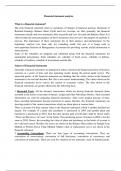Summary
Summary Financial statements analysis
- Course
- Institution
- Book
Introduction to Financial statements analysis Financial Statements Nature of Financial statements Features of Financial statements Objectives of Financial statements
[Show more]



